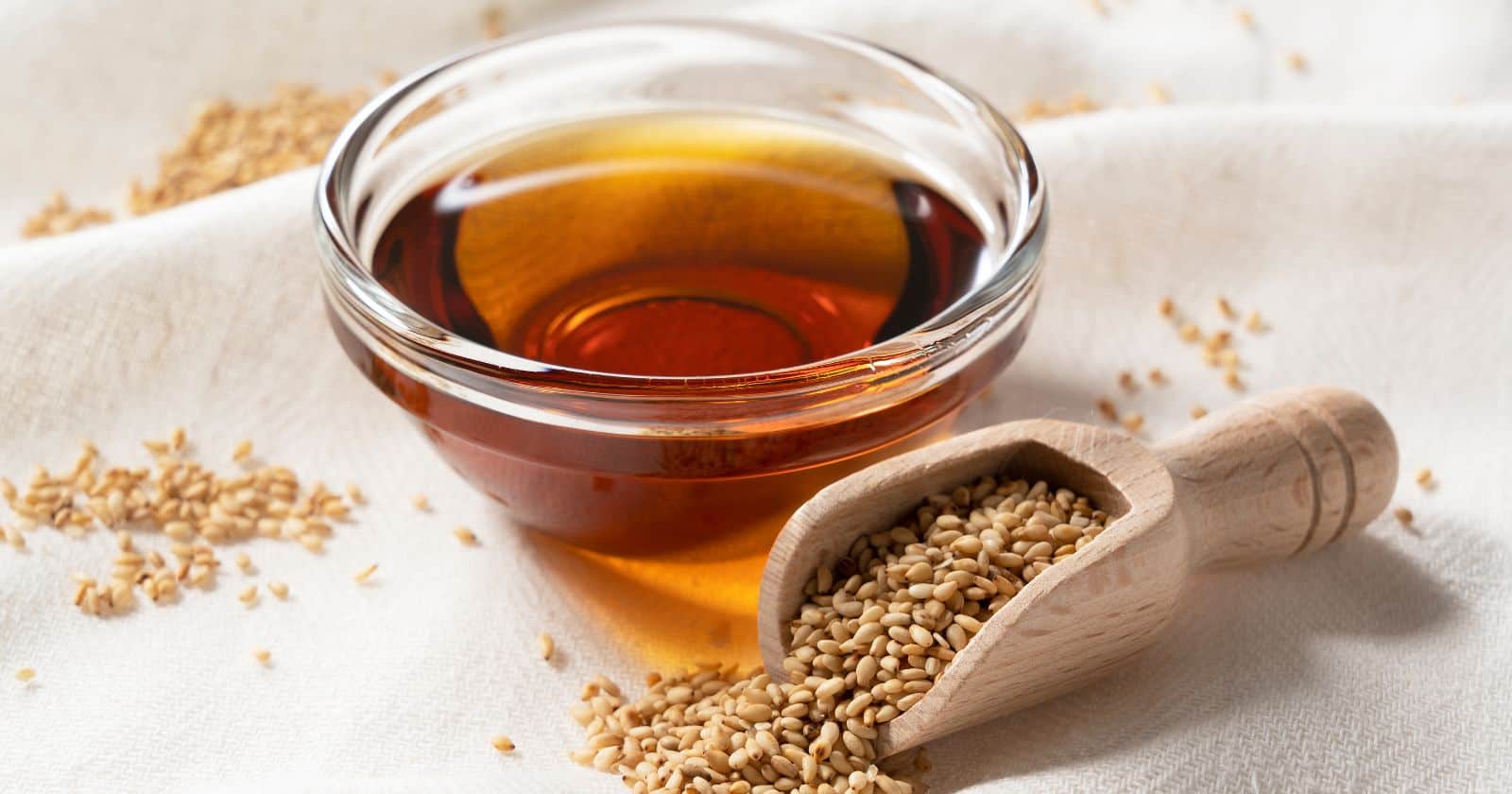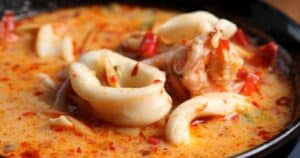Thai food lovers adore the cuisine’s explosive flavors. But if you avoid sesame oil or have allergies, you may wonder: Does Thai cooking rely on sesame oil like other Asian cuisines?
Let’s uncover the truth about sesame oil’s role in Thai cuisine. You’ll learn which oils are staples, which dishes incorporate sesame oil, and how to order Thai food that fits your dietary needs.
Is Sesame Oil a Key Thai Ingredient?

Here’s the short answer:
While sesame oil occasionally seasons Thai dishes, it is not a predominant ingredient in Thai cooking.
Instead, Thai cuisine favors oils like coconut, peanut, palm, and vegetable oil for frying, grilling, and stir-frying. Sesame oil provides a nutty aroma, but it’s overpowering taste means it’s used sparingly as a flavoring.
So if you avoid sesame oil, you need not write off Thai food entirely. With mindfulness of how it’s used, you can still savor the iconic flavors!
Next, let’s look at why sesame oil doesn’t headline Thai cooking like it does in other Asian cuisines.
Why Sesame Oil Plays a Supporting Role in Thai Cuisine
Sesame oil adds wonderful nutty notes, but its strong flavor is best used judiciously. Here’s why it takes a backseat to other oils in Thai cooking:
Thin, Low Smoke Point
Refined sesame oil has a low smoke point of about 350°F. Heating it over moderately high heat causes the oil to break down, losing its flavor.
For quick, high-heat techniques like stir-frying and deep-frying, cooks need oils with higher smoke points that won’t burn or become bitter.
Strong, Distinct Taste
Valued for its intense, toasty sesame flavor, the oil easily overpowers other ingredients. Using sesame oil as the main cooking oil alters the entire dish’s flavor profile.
The pronounced taste limits its versatility. It complements certain Asian dishes but detracts from others.
Not Traditionally Used
Unlike Chinese cuisine, sesame oil was not historically used in Thai cooking. Traditional Thai oils included rendered pork fat and coconut oil.
Today, peanut, palm, vegetable, and coconut oil are staples—not sesame. Authentic Thai flavor comes from herbs, chili pastes, fish sauce, and citrus.
Sesame oil isn’t part of Thailand’s culinary heritage. Adding it changes, rather than enhances, traditional Thai taste.
Oils That Are Thai Cooking Staples
Let’s look at the oils genuinely integral to Thai cuisine:
Coconut Oil
The queen of Thai oils, coconut oil is used for frying, stir-frying, and making curry pastes. Benefits include:
- Distinct coconut flavor
- High smoke point of 350°F
Palm Oil
Valued for its high smoke point and mild flavor, palm oil excels for deep frying and stir-frying.
Peanut Oil
With its 350°F smoke point, peanut oil is perfect for stir-fries. It also adds a subtle nutty flavor.
Vegetable/Soybean Oil
Flavorless vegetable and soybean oils allow the fresh Thai ingredients to shine in dishes.
Rice Bran Oil
A healthy oil sometimes used for its high smoke point and mild, buttery flavor.
These traditional oils define the Thai cooking experience—not strong sesame oil. But a few dishes do incorporate sesame oil sparingly.
Notable Thai Dishes That Use Sesame Oil
While uncommon, some Thai staples like pad thai use sesame oil for its nutty aroma. Popular dishes include:
Pad Thai
A few teaspoons of sesame oil adds nuttiness to the iconic noodle dish flavored with tamarind, fish sauce, peanuts, and dried shrimp.
Thai Fried Rice
Sesame oil is sometimes used to scent fried rice made with egg, soy sauce, garlic, scallions, chicken or shrimp, and vegetables.
Tom Yum Soup
The spicy Thai soup occasionally uses a touch of sesame oil along with lemongrass, kaffir lime leaves, chilies, and mushrooms.
Thai Green Curry
Some chefs add a drizzle of sesame oil to the coconut milk-based curry for aroma.
Note that sesame oil may be omitted from or used sparingly in these dishes. It enhances but isn’t fundamental to Thai cuisine’s flavor.
Ordering Tips for Avoiding Sesame Oil
If you’re allergic to or avoid sesame oil, you can still savor Thai food. Just remember these ordering tips:
Ask About the Oil
Don’t assume dishes are sesame oil-free. Politely ask if any are used in preparation.
Request Alternate Oils
Ask for peanut, vegetable, or coconut oil instead of sesame oil.
Look for Sesame Seed-Free Options
Sesame seeds often garnish pad thai. Request no seeds or garnishes.
Order Fresh, Vegetable-Based Dishes
Fresh herbs, produce, proteins and rice or noodles are less likely to have added sesame oil.
Modify Stir-Fries
Opt for lighter stir-fries using water or broth instead of large amounts of oil.
Bring Your Own Oil
Offer to provide your own peanut or coconut oil to use for cooking.
Explain Allergy Concerns
Clearly explain sesame allergies so the kitchen avoids cross-contamination.
With mindfulness and customization, those avoiding sesame oil can immerse in Thai cuisine’s amazing flavors. A few adjustments open up a world of tantalizing dishes!
Alternatives to Sesame Oil in Thai Cooking
Home cooks can easily substitute other oils in Thai recipes calling for sesame oil:
Coconut Oil
Provides subtly sweet flavor and creamy texture perfect for Thai curries.
Peanut Oil
Adds a nutty note and high smoke point ideal for stir-fries.
Avocado Oil
Has a mild flavor with a high 500°F smoke point to withstand cooking heat.
Grapeseed Oil
A versatile, neutral-flavored oil excellent for sautéing.
Toasted Sesame Seed Garnish
Sprinkle untoasted sesame seeds over a finished dish for nutty flavor without the oil.
With a variety of oil options, you can still enjoy authentic Thai cuisine flavors if you avoid sesame oil.
Thai Food Can Fit Any Dietary Need
Sesame oil may feature in a few Thai staples, but it doesn’t define Thai cuisine’s taste. With planning and customization, Thai food can suit any diet:
Vegan/Vegetarian
Veggie-centric options like pad thai, curry, and stir-fries abound. Just ask for no oyster or fish sauce.
Gluten-Free
Rice and veggie dishes are gluten-free. Verify no wheat-based soy sauce is used.
Nut Allergies
Beware of peanut sauce and garnishes. Request nut-free preparation.
Low-Sodium
Ask for low-sodium soy sauce and easy on salty fish sauce or shrimp paste.
Diabetes-Friendly
Avoid sugary sauces, rice, noodles and desserts. Focus on lean proteins and veggies.
So don’t make assumptions about menu limitations. With thoughtful questions and orders, Thai food can satisfy all preferences and dietary needs.
Satisfy your taste buds without fear by understanding how Thai cuisine really uses sesame oil. A few small tweaks open up a sensory journey through fresh, herbaceous Thai flavors. Just be sure to clearly communicate any sesame oil concerns. Then prepare your palate for a flavorful adventure!





